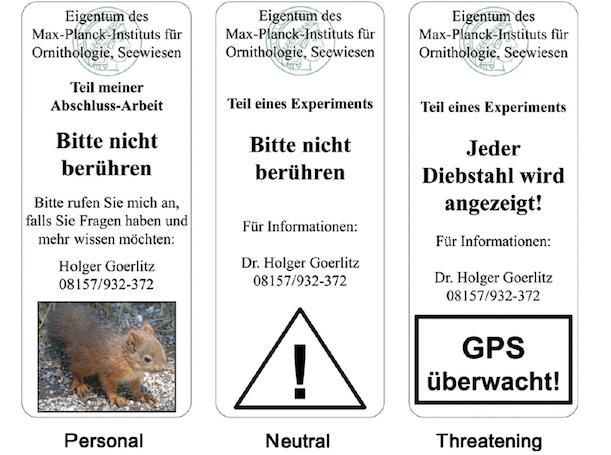How Do You Protect Scientific Equipment From Vandals? With A Friendly Warning
A friendly label, instead of a threatening warning, might cut down on the vandalization and theft of scientific instruments
/https://tf-cmsv2-smithsonianmag-media.s3.amazonaws.com/filer/c4/57/c457ec06-380b-42cc-8827-c98fca3c850d/scientific-equipment.jpg)
Scientific equipment that's left unattended in the field can provide all sorts of interesting information. It can, for instance, snap photographs of exotic and shy wild animals, or analyze the noises coming from an ecosystem to identify the species living there.
But often, leaving valuable instruments scattered outside risks interference or destruction from an unavoidable force of nature: humans. Data isn't regularly collected or published on the topic, but it's well known among field scientists that leaving equipment in highly-trafficked areas leaves it vulnerable to petty vandalism and theft.
This unfortunate trend was recently on the mind of Holger Goerlitz, a scientist at Germany's Max Planck Institute for Ornithology who studies animal behavior (specifically, how bats use echolocation within their environment) and leaves his field equipment unattended to do so. "As part of a project, I wanted to deploy automated equipment that would sit in the field for several nights," he says. "So my colleagues and I were concerned about how to protect this equipment. We considered using chains and video cameras. And then suddenly we had this random idea: Let's see what would be a good label to attach to the equipment to reduce vandalism."
His team's results, based on 60 pieces of fake scientific equipment scattered in four different Munich parks and published last week in Methods in Ecology and Evolution, may surprise you. They found that friendly labels that gave information about the project and the researcher led to about 40 percent fewer instances of equipment interference—either theft, vandalism or park visitors simply moving or trying to open up the equipment—as compared to neutral labels or ones that threatened surveillance and punishment.
They found this out by distributing boxes that looked vaguely like scientific instruments (above)—basically, plastic boxes with car antennas and fake cameras attached—for one week in each park, right next to a footpath, and checking for interference with the objects daily. All of the boxes had a similar warning label identifying it as properly of the Planck Institute and giving Goerlitz' contact information, but the tone of the messages differed slightly.
A third of the boxes had neutral messages (translated to English, they read "Part of an experiment—Please do not touch"), while another third had threatening warnings ("‘Part of an experiment—Every theft will be reported to the police! GPS monitored!") and the remaining third had a friendly, personalized note ("Part of my thesis–Please do not touch–Please call me if you have any questions and would like to know more.") The friendly label also had a picture of a juvenile squirrel, to give passersby an idea of the researcher's work:

The researchers checked the boxes daily, and had even placed pebbles inside so they could determine if the boxes had been picked up and moved. They also counted how many were pried open, vandalized or stolen.
Apparently, at least in these German city parks, the impulse to steal or vandalize is one that can be dislodged by just a bit of information about the potential victim, presented in a friendly way. Simply knowing that the device was important to one particular researcher—likely a student, given the word "thesis"—led visitors to interfere with the equipment about half as frequently. Over the course of a month, 39 instances of interference occurred with a box with a friendly label, compared to 59 with a neutral label and 67 with a threatening label.
Although the researchers were heartened by the finding, they were surprised, especially due to the fact that the threatening labels were the least successful. They imagine that the friendly label worked primarily by establishing the personal connection, perhaps aided by the squirrel photo, but the threatening label's ineffectiveness is a mystery. "We don't know why this was the case," Goerlitz says. "It could be that people didn't believe the threatening label, or that they thought, 'oh, there's a GPS device inside, this could be valuable.'" The fact that it was the only label that included the word "theft" might indicate that simply implanting the idea in people's minds influenced them to engage in it.
But, although there's obviously a lot more work to be done—this was conducted with a small sample of people over a short time period in one particular German city—this finding about friendly labels is a positive and potentially helpful one. If presented with the chance, people can be influenced to help science succeed if they're treated in a respectful way and informed about what's going on. Despite the enormous amount of money spent annually on scientific equipment, very little research has actually been done in this area to date, and more work to see how this might apply to people in different cultures, for instance, may aid scientists around the world in their efforts to protect their surveying instruments.
Goerlitz, for one, is ready to start using this finding to better safeguard his own equipment that monitors bat echolocation. "In my labels, I'll try to be informative and friendly to people," he says. "I think if you expose people to what you're doing, they'll be much more supportive of it."
/https://tf-cmsv2-smithsonianmag-media.s3.amazonaws.com/accounts/headshot/joseph-stromberg-240.jpg)
/https://tf-cmsv2-smithsonianmag-media.s3.amazonaws.com/accounts/headshot/joseph-stromberg-240.jpg)